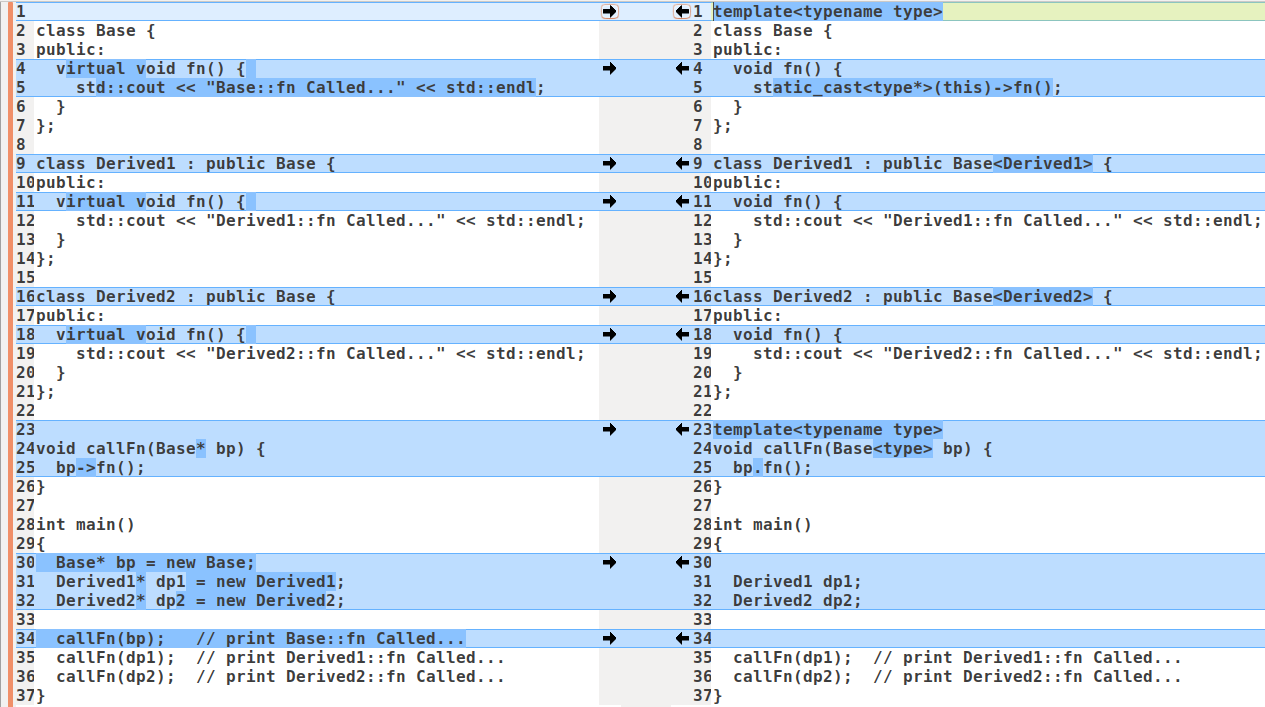SFINAE
https://modern-cpp.readthedocs.io/zh_CN/latest/sfinae.html
1
2
3
4
5
6
7
8
static auto Anyone = [](auto&& k, auto&&... args) { return ((args == k) || ...); };
string s="autumn";
//等价于 if(s=="spring" || s== "summer" || s == "autumn" || s == "winter")
if (Anyone(s, "spring", "summer", "autumn", "winter")) {
...
}
RAII与pImpl
RAII(Resource Acquisition Is Initialization),也称为”资源获取即初始化”,是C++里一种资源管理,避免泄漏的惯用法。
C++标准保证在任何情况下,已构造的对象最终会被销毁,即对象的析构函数最终会被调用。
RAII应用
ScopeGuard
C++提供了一个叫ScopeGuard的关键技术:通过局部变量析构函数来管理资源,根据是否正常退出来决定是否需要清理资源。
1
2
3
4
5
6
7
8
9
10
11
12
13
14
15
16
17
18
19
20
21
22
23
24
25
26
27
28
29
30
31
32
33
34
35
36
37
38
39
40
41
42
43
44
45
46
47
48
49
50
51
52
53
54
55
56
template <typename F>
class ScopeGuard {
public:
ScopeGuard(F&& fn): m_fn(fn), m_active(true) {}
~ScopeGuard() {
if (m_active) {
m_fn();
}
}
void dismiss() {
m_active = false;
}
private:
F m_fn;
bool m_active;
};
struct ScopeGuardOnExit {};
template <typename F>
static inline ScopeGuard<F> operator+(ScopeGuardOnExit, F&& fn) {
return ScopeGuard<F>(std::forward<F>(fn));
}
#define ON_SCOPE_EXIT \
auto __onGuardExit__ = ScopeGuardOnExit{} + [&]
#define CANCEL_SCOPRE_EXIT \
__onGuardExit__.dismiss()
bool protcess1(char* buf) {
return true;
}
bool protcess2(char* buf) {
return true;
}
void process() {
char* buf = (char*)malloc(512);
// 函数退出时,执行ON_SCOPE_EXIT代码,资源释放统一放在这里
ON_SCOPE_EXIT {
free(buf);
printf("exit func, free buf.");
};
if (!protcess1(buf)) {
return;
}
if (!protcess2(buf)) {
return;
}
}
RAII妙用之计算函数耗时
OutOfLine
OutOfLine的基本原理是把对象内部的数据分为热数据和冷数据,把冷数据放在对象外面保存。这样可以提升热数据的内存局部性,减少cache miss,从而获得更好的性能,同时不破坏原有对象的封装和RAII特性。
OutOfLine – A Memory-Locality Pattern for High Performance C++
模板特化
- 允许某些形式的优化
- 减少代码膨胀
偏特化有两种:
- 模板参数个数上,比如,有2个模板参数,特化其中一个
- 模板参数范围上,比如,有个任意类型的模板参数,特化成指向任意类型的指针类型
Why Not Specialize Function Templates?
CRTP
CRTP(Curiously Recurring Template Pattern): 奇异递归模板模式.
基本形式
1
2
3
4
5
6
7
8
9
10
11
// The Curiously Recurring Template Pattern(CRTP)
template <class T>
class Base
{
// methods within Base can use template to access members of Derived
};
class Derived : public Base<Derived>
{
// ...
};
典型应用
静态多态(编译时多态)
不使用虚函数但是达到了多态的效果。应用常见于各种各样的C++库,像boost里面就有大量使用,STL中也有一些。在C++里面,模板函数本身就不能定义为虚函数,因此,对于模板函数来说,要达到多态的效果,CRTP是一种非常好的途径,而且还没有虚函数的开销。
- 动态多态(运行时多态)的例子
1
2
3
4
5
6
7
8
9
10
11
12
13
14
15
16
17
18
19
20
21
22
23
24
25
26
27
28
29
30
31
32
33
34
35
36
class Base {
public:
virtual void fn() {
std::cout << "Base::fn Called..." << std::endl;
}
};
class Derived1 : public Base {
public:
virtual void fn() {
std::cout << "Derived1::fn Called..." << std::endl;
}
};
class Derived2 : public Base {
public:
virtual void fn() {
std::cout << "Derived2::fn Called..." << std::endl;
}
};
void callFn(Base* bp) {
bp->fn();
}
int main()
{
Base* bp = new Base;
Derived1* dp1 = new Derived1;
Derived2* dp2 = new Derived2;
callFn(bp); // print Base::fn Called...
callFn(dp1); // print Derived1::fn Called...
callFn(dp2); // print Derived2::fn Called...
}
- 静态多态(编译时多态)的例子
1
2
3
4
5
6
7
8
9
10
11
12
13
14
15
16
17
18
19
20
21
22
23
24
25
26
27
28
29
30
31
32
33
34
35
template<typename type>
class Base {
public:
void fn() {
static_cast<type*>(this)->fn();
}
};
class Derived1 : public Base<Derived1> {
public:
void fn() {
std::cout << "Derived1::fn Called..." << std::endl;
}
};
class Derived2 : public Base<Derived2> {
public:
void fn() {
std::cout << "Derived2::fn Called..." << std::endl;
}
};
template<typename type>
void callFn(Base<type> bp) {
bp.fn();
}
int main()
{
Derived1 dp1;
Derived2 dp2;
callFn(dp1); // print Derived1::fn Called...
callFn(dp2); // print Derived2::fn Called...
}
两者写法对比

对象计数器
Polymorphic chaining
Polymorphic copy construction
Expression Template
一个比较优秀的应用就是Eigen库。